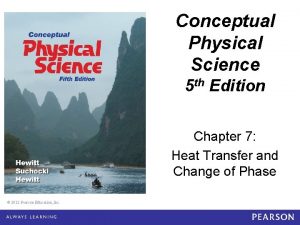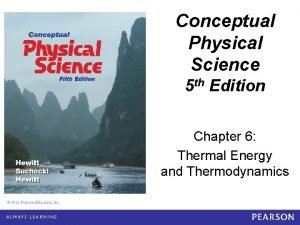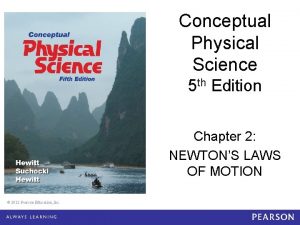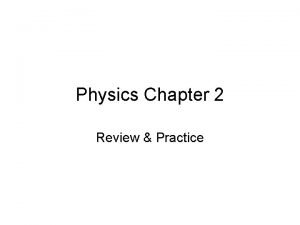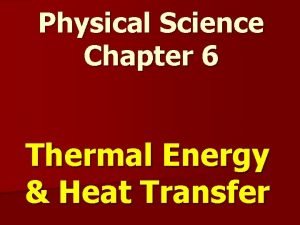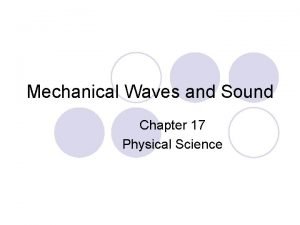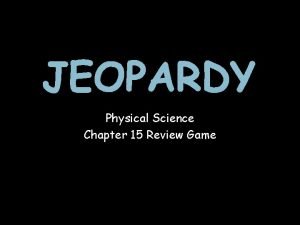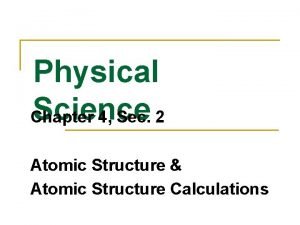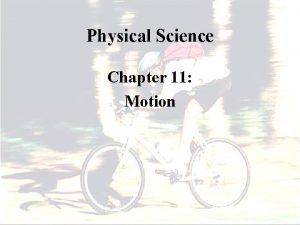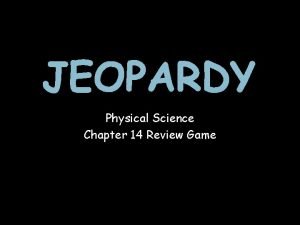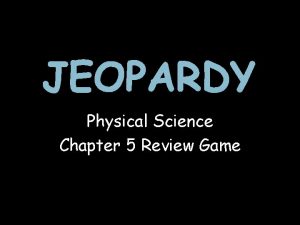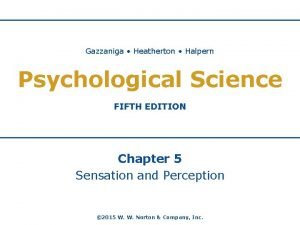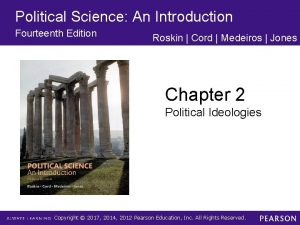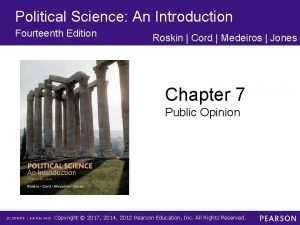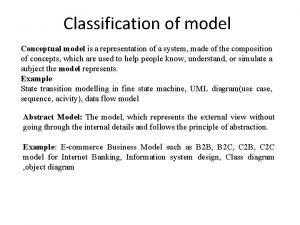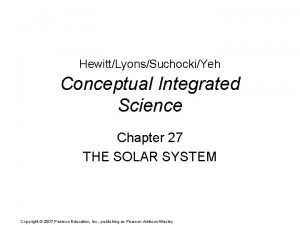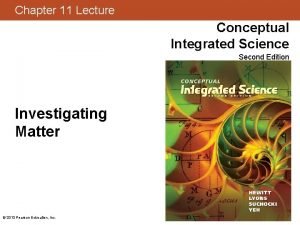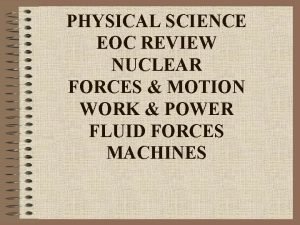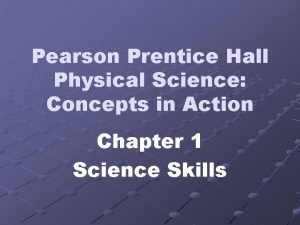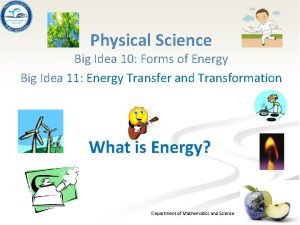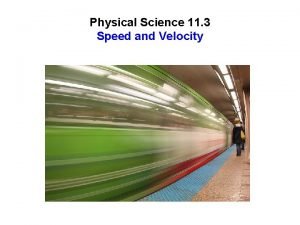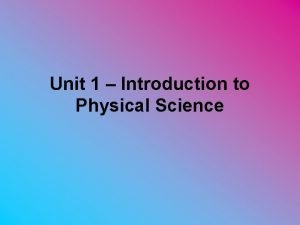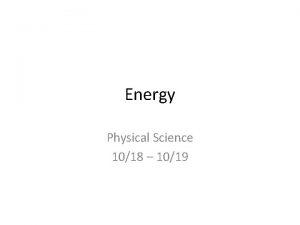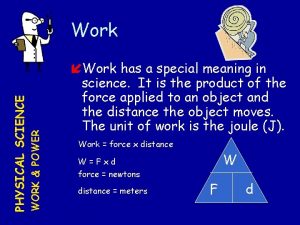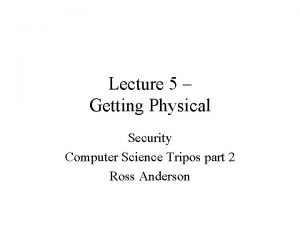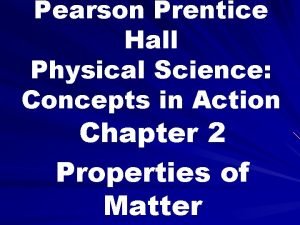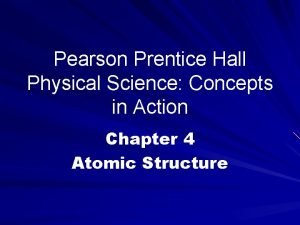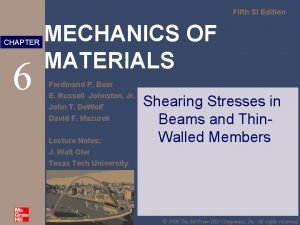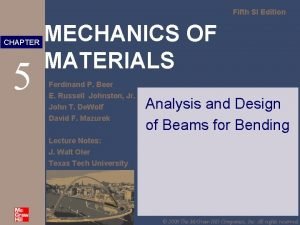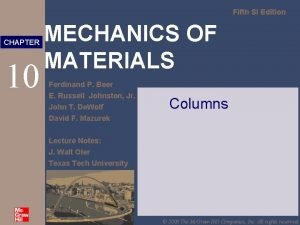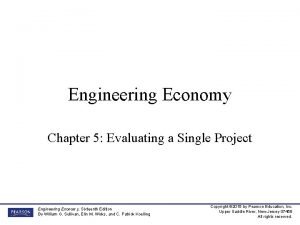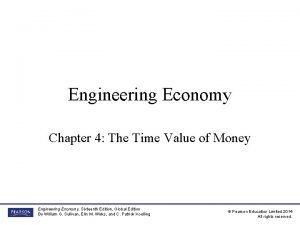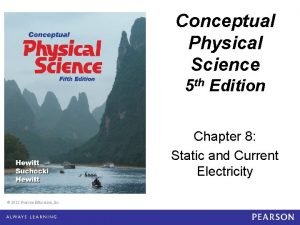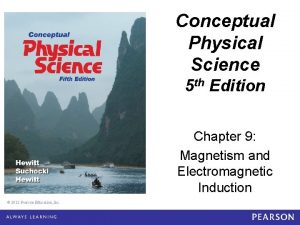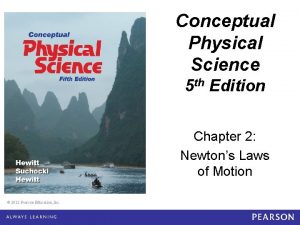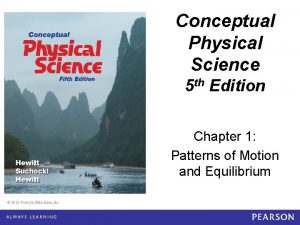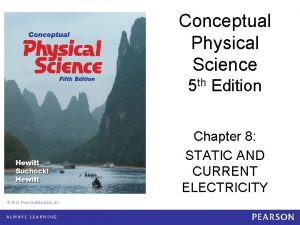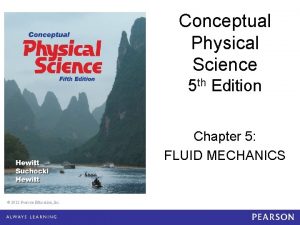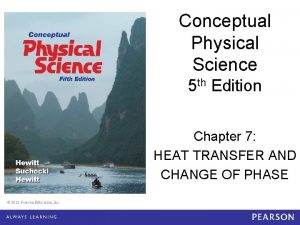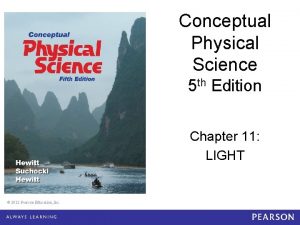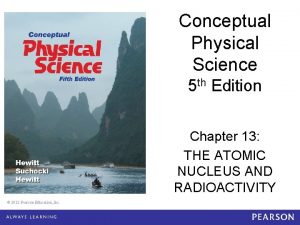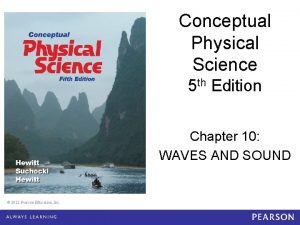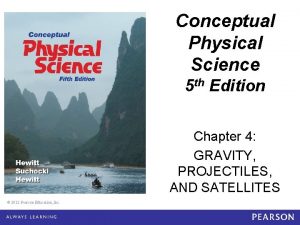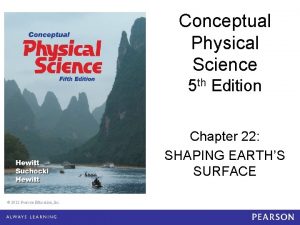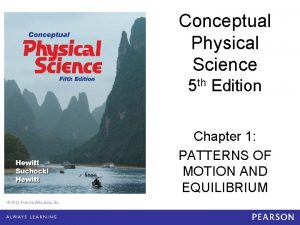Conceptual Physical Science 5 th Edition Chapter 2












































































- Slides: 76

Conceptual Physical Science 5 th Edition Chapter 2: NEWTON’S LAWS OF MOTION © 2012 Pearson Education, Inc.

This lecture will help you understand: • • • Newton’s First Law of Motion Newton’s Second Law of Motion Forces and Interactions Newton’s Third Law of Motion Summary of Newton’s Three Laws © 2012 Pearson Education, Inc.

Newton’s First Law of Motion The law of inertia: (originating with Galileo) Every object continues in a state of rest or of uniform speed in a straight line unless acted on by a nonzero force. © 2012 Pearson Education, Inc.

Newton’s First Law of Motion CHECK YOUR NEIGHBOR A sheet of paper can be quickly withdrawn from under a soft-drink can without the can toppling, because A. B. C. D. gravity pulls harder on the can than on the paper. the can has weight. the can has inertia. None of the above. © 2012 Pearson Education, Inc.

Newton’s First Law of Motion CHECK YOUR ANSWER A sheet of paper can be quickly withdrawn from under a soft-drink can without the can toppling, because A. B. C. D. gravity pulls harder on the can than on the paper. the can has weight. the can has inertia. None of the above. © 2012 Pearson Education, Inc.

Newton’s First Law of Motion CHECK YOUR NEIGHBOR If you swing a stone overhead in a horizontal circle and the string breaks, the tendency of the stone is to follow a A. B. C. D. curved path. straight-line path. spiral path. vertical path. © 2012 Pearson Education, Inc.

Newton’s First Law of Motion CHECK YOUR ANSWER If you swing a stone overhead in a horizontal circle and the string breaks, the tendency of the stone is to follow a A. B. C. D. curved path. straight-line path. spiral path. vertical path. © 2012 Pearson Education, Inc.

Examples of Inertia © 2012 Pearson Education, Inc.

Inertia in Action • Rapid deceleration is sensed by the driver who lurches forward. • It is also an example of Newton’s Second Law because no force stops the driver while the brakes stop the vehicle. © 2012 Pearson Education, Inc.

Inertia in Action • When you flip a coin in a high-speed airplane, it behaves as if the airplane were at rest. • The coin keeps up with you. © 2012 Pearson Education, Inc.

Inertia in Action • Can the bird drop down and catch the worm if the Earth moves at 30 km/s? © 2012 Pearson Education, Inc.

Newton’s Second Law of Motion The law of acceleration: The acceleration produced by a net force on an object is directly proportional to the net force, is in the same direction as the net force, and is inversely proportional to the mass of the object. © 2012 Pearson Education, Inc.

Newton’s Second Law of Motion Newton’s second law in equation form: small net force, large mass small acceleration large net © 2012 Pearson Education, Inc. force, small mass large acceleration

Newton’s Second Law of Motion CHECK YOUR NEIGHBOR Consider a cart pushed along a track with a certain force. If the force remains the same while the mass of the cart decreases to half, the acceleration of the cart A. B. C. D. remains the same. halves. doubles. changes unpredictably. © 2012 Pearson Education, Inc.

Newton’s Second Law of Motion CHECK YOUR ANSWER Consider a cart pushed along a track with a certain force. If the force remains the same while the mass of the cart decreases to half, the acceleration of the cart A. B. C. D. remains the same. halves. doubles. changes unpredictably. © 2012 Pearson Education, Inc.

Newton’s Second Law of Motion CHECK YOUR NEIGHBOR Push a cart along a track so twice as much net force acts upon it. If the acceleration remains the same, what is a reasonable explanation? A. B. C. D. The mass of the cart doubled when the force doubled. The cart experiences a force that it didn’t before. The track is not level. Friction reversed direction. © 2012 Pearson Education, Inc.

Newton’s Second Law of Motion CHECK YOUR ANSWER Push a cart along a track so twice as much net force acts upon it. If the acceleration remains the same, what is a reasonable explanation? A. B. C. D. The mass of the cart doubled when the force doubled. The cart experiences a force that it didn’t before. The track is not level. Friction reversed direction. © 2012 Pearson Education, Inc.

Newton’s Second Law of Motion When acceleration is g—free fall. When the only force acting on a falling object is gravity, with negligible air resistance, the object is in free fall. An object in free fall accelerates toward Earth at 10 m/s per second. © 2012 Pearson Education, Inc.

Newton’s Second Law of Motion CHECK YOUR NEIGHBOR At one instant an object in free fall has a speed of 40 m/s. Its speed one second later is A. B. C. D. also 40 m/s. 45 m/s. 50 m/s. none of the above. © 2012 Pearson Education, Inc.

Newton’s Second Law of Motion CHECK YOUR ANSWER At one instant an object in free fall has a speed of 40 m/s. Its speed one second later is A. B. C. D. also 40 m/s. 45 m/s. 50 m/s. none of the above. Explanation: We assume the object is falling downward. © 2012 Pearson Education, Inc.

Newton’s Second Law of Motion When acceleration is g—free fall. Twice the force on twice the mass same acceleration as half the force on half the mass. © 2012 Pearson Education, Inc.

Newton’s Second Law of Motion CHECK YOUR NEIGHBOR A 5 -kg iron ball and a 10 -kg iron ball are dropped from rest. For negligible air resistance, the acceleration of the heavier ball will be A. B. C. D. less. the same. more. undetermined. © 2012 Pearson Education, Inc.

Newton’s Second Law of Motion CHECK YOUR ANSWER A 5 -kg iron ball and a 10 -kg iron ball are dropped from rest. For negligible air resistance, the acceleration of the heavier ball will be A. B. C. D. less. the same. more. undetermined. © 2012 Pearson Education, Inc.

Newton’s Second Law of Motion CHECK YOUR NEIGHBOR A 5 -kg iron ball and a 10 -kg iron ball are dropped from rest. When the free-falling 5 -kg iron ball reaches a speed of 10 m/s, the speed of the free-falling 10 -kg iron ball is A. B. C. D. less than 10 m/s. more than 10 m/s. undetermined. © 2012 Pearson Education, Inc.

Newton’s Second Law of Motion CHECK YOUR ANSWER A 5 -kg iron ball and a 10 -kg iron ball are dropped from rest. When the free-falling 5 -kg iron ball reaches a speed of 10 m/s, the speed of the free-falling 10 -kg iron ball is A. B. C. D. less than 10 m/s. more than 10 m/s. undetermined. © 2012 Pearson Education, Inc.

Newton’s Second Law of Motion When acceleration is g—free fall. The ratio of weight to mass is the same for all falling objects in the same locality; hence, their accelerations are the same in the absence of air resistance. © 2012 Pearson Education, Inc.

Newton’s Second Law of Motion When acceleration is g — free fall. Demonstration of a feather and a coin in a vacuum. In a vacuum, a feather and a coin fall together at g—the acceleration due to gravity. © 2012 Pearson Education, Inc.

Newton’s Second Law of Motion A situation to ponder… When an air-filled glass tube containing a coin and a feather is inverted, the coin falls quickly to the bottom of the tube while the feather flutters to the bottom. © 2012 Pearson Education, Inc.

A situation to ponder… CHECK YOUR NEIGHBOR When the air is removed by a vacuum pump and the activity is repeated, A. B. C. D. the feather hits the bottom first, before the coin hits the bottom first, before the feather hits. both the coin and feather drop together side by side. Not enough information. © 2012 Pearson Education, Inc.

A situation to ponder… CHECK YOUR ANSWER When the air is removed by a vacuum pump and the activity is repeated, A. B. C. D. the feather hits the bottom first, before the coin hits the bottom first, before the feather hits. both the coin and feather drop together side by side. Not enough information. © 2012 Pearson Education, Inc.

Newton’s Second Law of Motion When acceleration is less than g — non-free fall. Non-free fall occurs when two forces act on a falling object • a force due to gravity acting downward • air resistance acting upward © 2012 Pearson Education, Inc.

Newton’s Second Law of Motion CHECK YOUR NEIGHBOR When a 20 -N falling object encounters 5 N of air resistance, its acceleration of fall is A. B. C. D. less than g. more than g. g. terminated. © 2012 Pearson Education, Inc.

Newton’s Second Law of Motion CHECK YOUR ANSWER When a 20 -N falling object encounters 5 N of air resistance, its acceleration of fall is A. B. C. D. less than g. more than g. g. terminated. Explanation: Acceleration of non-free fall is always less than g. Acceleration will actually be (20 N – 5 N)/2 kg = 7. 5 N/kg = 7. 5 m/s 2. © 2012 Pearson Education, Inc.

Newton’s Second Law of Motion When acceleration is less than g—non-free fall • as falling object gains speed, force exerted by surrounding air increases • force of air resistance may continue to increase until it equals the weight • at this point, net force is zero and no further acceleration • object has reached terminal velocity—continues falling at constant velocity with no acceleration © 2012 Pearson Education, Inc.

Newton’s Second Law of Motion CHECK YOUR NEIGHBOR If a 50 -N person is to fall at terminal speed, the air resistance needed is A. B. C. D. less than 50 N. more than 50 N. None of the above. © 2012 Pearson Education, Inc.

Newton’s Second Law of Motion CHECK YOUR ANSWER If a 50 -N person is to fall at terminal speed, the air resistance needed is A. B. C. D. less than 50 N. more than 50 N. None of the above. Explanation: Then F = 0 and acceleration = 0. © 2012 Pearson Education, Inc.

Newton’s Second Law of Motion CHECK YOUR NEIGHBOR As a skydiver falls faster and faster through the air, air resistance A. B. C. D. increases. decreases. remains the same. Not enough information. © 2012 Pearson Education, Inc.

Newton’s Second Law of Motion CHECK YOUR ANSWER As a skydiver falls faster and faster through the air, air resistance A. B. C. D. increases. decreases. remains the same. Not enough information. © 2012 Pearson Education, Inc.

Newton’s Second Law of Motion CHECK YOUR NEIGHBOR As a skydiver continues to fall faster and faster through the air, net force A. B. C. D. increases. decreases. remains the same. Not enough information. © 2012 Pearson Education, Inc.

Newton’s Second Law of Motion CHECK YOUR ANSWER As a skydiver continues to fall faster and faster through the air, net force A. B. C. D. increases. decreases. remains the same. Not enough information. © 2012 Pearson Education, Inc.

Newton’s Second Law of Motion CHECK YOUR NEIGHBOR As a skydiver continues to fall faster and faster through the air, her acceleration A. B. C. D. increases. decreases. remains the same. Not enough information. © 2012 Pearson Education, Inc.

Newton’s Second Law of Motion CHECK YOUR ANSWER As a skydiver continues to fall faster and faster through the air, her acceleration A. B. C. D. increases. decreases. remains the same. Not enough information. © 2012 Pearson Education, Inc.

Newton’s Second Law of Motion A situation to ponder… Consider a heavy and light person with same-size parachutes jumping together from the same altitude. © 2012 Pearson Education, Inc.

A situation to ponder… CHECK YOUR NEIGHBOR Who will reach the ground first? A. B. C. D. The light person. The heavy person. Both at the same time. Not enough information. © 2012 Pearson Education, Inc.

A situation to ponder… CHECK YOUR ANSWER Who will reach the ground first? A. B. C. D. The light person. The heavy person. Both at the same time. Not enough information. Explanation: The heavier person has a greater terminal velocity. Do you know why? © 2012 Pearson Education, Inc.

Forces and Interactions Force is simply a push or a pull. Interaction occurs between one thing and another. Example: When you push against a wall, you’re interacting with the wall. © 2012 Pearson Education, Inc.

Newton’s Third Law of Motion Law of action and reaction: Whenever one object exerts a force on a second object, the second object exerts an equal and opposite force on the first. Example: When your hand presses on the wall, the wall simultaneously presses on your hand. Hand wall press on each other with equal and opposite forces. © 2012 Pearson Education, Inc.

Newton’s Third Law of Motion Action and reaction forces • one force is called the action force; the other force is called the reaction force • are copairs of a single interaction • neither force exists without the other • are equal in strength and opposite in direction • always act on different objects © 2012 Pearson Education, Inc.

Newton’s Third Law of Motion CHECK YOUR NEIGHBOR A soccer player kicks a ball with 1500 N of force. The ball exerts a reaction force against the player’s foot of A. B. C. D. somewhat less than 1500 N. somewhat more than 1500 N. None of the above. © 2012 Pearson Education, Inc.

Newton’s Third Law of Motion CHECK YOUR ANSWER A soccer player kicks a ball with 1500 N of force. The ball exerts a reaction force against the player’s foot of A. B. C. D. somewhat less than 1500 N. somewhat more than 1500 N. None of the above. © 2012 Pearson Education, Inc.

Newton’s Third Law of Motion Simple Rule to Identify Action and Reaction: Action— object A exerts a force on object B. Reaction— object B exerts a force on object A. © 2012 Pearson Education, Inc.

Newton’s Third Law of Motion CHECK YOUR NEIGHBOR When you step off a curb, Earth pulls you downward. The reaction to this force is A. B. C. D. a slight air resistance. nonexistent in this case. you pull Earth upward. None of the above. © 2012 Pearson Education, Inc.

Newton’s Third Law of Motion CHECK YOUR ANSWER When you step off a curb, Earth pulls you downward. The reaction to this force is A. B. C. D. a slight air resistance. nonexistent in this case. you pull Earth upward. None of the above. © 2012 Pearson Education, Inc.

Newton’s Third Law of Motion Action and Reaction on Different Masses: If the same force is applied to two objects of different masses, greater mass object small acceleration smaller mass object large acceleration © 2012 Pearson Education, Inc.

Newton’s Third Law of Motion CHECK YOUR NEIGHBOR When a cannon is fired, the accelerations of the cannon and cannonball are different, because the A. B. C. D. forces don’t occur at the same time. forces, although theoretically are the same, in practice aren’t the same. masses are different. ratios of force to mass are the same. © 2012 Pearson Education, Inc.

Newton’s Third Law of Motion CHECK YOUR ANSWER When a cannon is fired, the accelerations of the cannon and cannonball are different, because the A. B. C. D. forces don’t occur at the same time. forces, although theoretically are the same, in practice aren’t the same. masses are different. ratios of force to mass are the same. © 2012 Pearson Education, Inc.

Newton’s Third Law of Motion A situation to ponder… Consider a high-speed bus colliding head-on with an innocent bug. The force of impact splatters the unfortunate bug over the windshield. © 2012 Pearson Education, Inc.

A situation to ponder… CHECK YOUR NEIGHBOR Which is greater, the force on the bug or the force on the bus? A. B. C. D. Bug. Bus. Both are the same. Cannot say. © 2012 Pearson Education, Inc.

A situation to ponder… CHECK YOUR ANSWER Which is greater, the force on the bug or the force on the bus? A. B. C. D. Bug. Bus. Both are the same. Cannot say. Explanation: Although the forces are equal in magnitude, the effects are very different. Do you know why? © 2012 Pearson Education, Inc.

Newton’s Third Law of Motion CHECK YOUR NEIGHBOR Two people of equal mass on slippery ice push off from each other. Will both move at the same speed in opposite directions? A. B. C. D. Yes, but only if both push equally. No, unless acceleration occurs. © 2012 Pearson Education, Inc.

Newton’s Third Law of Motion CHECK YOUR ANSWER Two people of equal mass on slippery ice push off from each other. Will both move at the same speed in opposite directions? A. B. C. D. Yes, but only if both push equally. No, unless acceleration occurs. Explanation: However they push, the result is equal-magnitude forces on equal masses, which produce equal accelerations and, therefore, equal changes in speed. © 2012 Pearson Education, Inc.

Newton’s Third Law of Motion Defining Your System • consider a single enclosed orange – applied external force causes the orange to accelerate in accord with Newton’s second law – action and reaction pair of forces is not shown © 2012 Pearson Education, Inc.

Newton’s Third Law of Motion • consider the orange and the apple pulling on it – action and reaction do not cancel (because they act on different things) – external force by apple accelerates the orange © 2012 Pearson Education, Inc.

Newton’s Third Law of Motion • consider a system comprised of both the orange and the apple – the apple is no longer external to the system – force pair is internal to system, which doesn’t cause acceleration – action and reaction within the system cancel – with no external forces, there is no acceleration of system © 2012 Pearson Education, Inc.

Newton’s Third Law of Motion • consider the same system, but with external force of friction on it – same internal action and reaction forces (between the orange and apple) cancel – a second pair of action-reaction forces (between the apple’s feet and the floor) exists © 2012 Pearson Education, Inc.

Newton’s Third Law of Motion – one of these acts by the system (apple on the floor) and the other acts on the system (floor on the apple) – external frictional force of floor pushes on the system, which accelerates – second pair of action and reaction forces do not cancel © 2012 Pearson Education, Inc.

Newton’s Third Law CHECK YOUR NEIGHBOR When lift equals the weight of a helicopter, the helicopter A. B. C. D. climbs down. climbs up. hovers in midair. None of the above. © 2012 Pearson Education, Inc.

Newton’s Third Law CHECK YOUR ANSWER When lift equals the weight of a helicopter, the helicopter A. B. C. D. climbs down. climbs up. hovers in midair. None of the above. © 2012 Pearson Education, Inc.

Newton’s Third Law CHECK YOUR NEIGHBOR When lift is greater, the helicopter A. B. C. D. climbs down. climbs up. hovers in midair. None of the above © 2012 Pearson Education, Inc.

Newton’s Third Law CHECK YOUR ANSWER When lift is greater, the helicopter A. B. C. D. climbs down. climbs up. hovers in midair. None of the above © 2012 Pearson Education, Inc.

Newton’s Third Law CHECK YOUR NEIGHBOR A bird flies by A. B. C. D. flapping its wings. pushing air down so that the air pushes it upward. hovering in midair. inhaling and exhaling air. © 2012 Pearson Education, Inc.

Newton’s Third Law CHECK YOUR ANSWER A birds flies by A. B. C. D. flapping its wings. pushing air down so that the air pushes it upward. hovering in midair. inhaling and exhaling air. © 2012 Pearson Education, Inc.

Newton’s Third Law CHECK YOUR NEIGHBOR Slightly tilted wings of airplanes deflect A. B. C. D. oncoming air downward to produce lift. oncoming air upward to produce lift. Both of these. Neither of these. © 2012 Pearson Education, Inc.

Newton’s Third Law CHECK YOUR ANSWER Slightly tilted wings of airplanes deflect A. B. C. D. oncoming air downward to produce lift. oncoming air upward to produce lift. Both of these. Neither of these. Explanation: When a wing diverts air downward, it exerts a downward force on the air. The air simultaneously exerts an upward force on the wing. The vertical component of this upward force is lift. (The horizontal component is drag. ) © 2012 Pearson Education, Inc.

Newton’s Third Law CHECK YOUR NEIGHBOR Compared with a light-weight glider, a heavier glider would have to push air A. B. C. D. downward with greater force. downward with the same force. downward with less force. none of the above © 2012 Pearson Education, Inc.

Newton’s Third Law CHECK YOUR ANSWER Compared with a light-weight glider, a heavier glider would have to push air A. B. C. D. downward with greater force. downward with the same force. downward with less force. none of the above Explanation: The force on the air deflected downward must equal the weight of the glider. © 2012 Pearson Education, Inc.
 When air rapidly expands its temperature normally
When air rapidly expands its temperature normally Heat is simply another word for
Heat is simply another word for Conceptual physical science 5th edition
Conceptual physical science 5th edition Conceptual physical science practice sheet chapter 2
Conceptual physical science practice sheet chapter 2 Mind map of branches of science
Mind map of branches of science Natural science vs physical science
Natural science vs physical science My favorite subject is english because
My favorite subject is english because Using mis 10th edition
Using mis 10th edition Zulily case study
Zulily case study Physics chapter 2 review
Physics chapter 2 review Chapter 6 physical science
Chapter 6 physical science Chapter 14 review physical science
Chapter 14 review physical science Chapter 17 mechanical waves and sound
Chapter 17 mechanical waves and sound Physical science jeopardy
Physical science jeopardy Chapter 4 review physical science
Chapter 4 review physical science Chapter 11 physical science
Chapter 11 physical science Chapter 14 review physical science
Chapter 14 review physical science Physical science chapter 5 review
Physical science chapter 5 review Physical science chapter 6 review answers
Physical science chapter 6 review answers Chapter 16 review physical science
Chapter 16 review physical science Chemistry the central science 14th edition
Chemistry the central science 14th edition Biological science 6th edition
Biological science 6th edition Psychological science 5th edition
Psychological science 5th edition The fundamentals of political science research 2nd edition
The fundamentals of political science research 2nd edition Political science 14th edition
Political science 14th edition Political science 14th edition
Political science 14th edition Science power 9 atlantic edition
Science power 9 atlantic edition Conceptual physical and mathematical models are used to
Conceptual physical and mathematical models are used to Conceptual design vs physical design
Conceptual design vs physical design Conceptual integrated science explorations
Conceptual integrated science explorations Conceptual integrated science
Conceptual integrated science What is conceptual framework of science education
What is conceptual framework of science education Price fences marketing
Price fences marketing Physical fitness components and tests grade 9
Physical fitness components and tests grade 9 Sains pada kurikulum paud
Sains pada kurikulum paud Periodic table jeopardy
Periodic table jeopardy Physical science final exam review
Physical science final exam review Science eoc review
Science eoc review Physical science eoc review
Physical science eoc review Chapter 4 section 1 work and machines answer key
Chapter 4 section 1 work and machines answer key Which is a “big idea” of physical science?
Which is a “big idea” of physical science? Physical science lecture notes
Physical science lecture notes Prentice hall physical science: concepts in action
Prentice hall physical science: concepts in action Physical science force
Physical science force Pascc
Pascc What is displacement in physical science
What is displacement in physical science Types of energy
Types of energy Velocity physical science
Velocity physical science Exploring physical science
Exploring physical science Waves physics pdf
Waves physics pdf The science duo physical and chemical changes
The science duo physical and chemical changes Physical science scientific notation worksheet answers
Physical science scientific notation worksheet answers Example of testimonial evidence
Example of testimonial evidence Pearson physical science concepts in action
Pearson physical science concepts in action Physical science
Physical science Wxhwebsite
Wxhwebsite Physical science
Physical science Physical science 436
Physical science 436 Physical security computer science
Physical security computer science Physical science bell ringers
Physical science bell ringers Chemical property definition
Chemical property definition Pearson physical science concepts in action
Pearson physical science concepts in action Kuiper belt def
Kuiper belt def Organizational behavior 18th edition
Organizational behavior 18th edition Thermodynamic vs kinetic control
Thermodynamic vs kinetic control Mechanics of materials chapter 10 solutions
Mechanics of materials chapter 10 solutions Mechanics of materials 6th edition solutions chapter 7
Mechanics of materials 6th edition solutions chapter 7 Mechanics of materials chapter 6
Mechanics of materials chapter 6 Johnston beam
Johnston beam Mechanics of materials 6th edition solutions chapter 10
Mechanics of materials 6th edition solutions chapter 10 Everything's an argument 8th edition chapter 1
Everything's an argument 8th edition chapter 1 Chapter 6 portable fire extinguishers
Chapter 6 portable fire extinguishers Engineering economy 16th edition chapter 5 solutions
Engineering economy 16th edition chapter 5 solutions Deffered annuity
Deffered annuity Business essentials 12th edition
Business essentials 12th edition Psychology ciccarelli 5th edition chapter 1
Psychology ciccarelli 5th edition chapter 1 Prehospital emergency care 11th edition
Prehospital emergency care 11th edition
